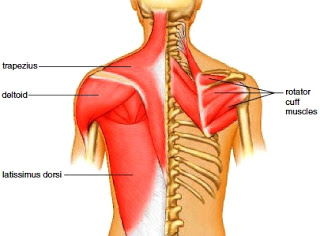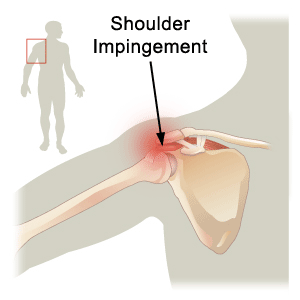The start of fall sports season has begun filling OSR with high school sports injuries. This post will cover a common injury in swimmers : Swimmer’s shoulder.
Historically swimmer’s shoulder has been any pain in, or around the shoulder of a competitive swimmer. Specifically it is a type of impingement of the tendons of the rotator cuff muscles as they pass over the ball of the shoulder joint. Unlike “standard” impingement, swimmer shoulder is much more commonly associated with too much mobility in the shoulder joint as well as the shoulder blade.
Due to the propulsion required by the upper body with all swim strokes, swimmers often demonstrate a stereotypically rounded, or forward shoulder posture. This posture is a result of weakness of the muscles that stabilize the shoulder blade (trapezius and rhomboids) as well as the rotator cuff, along with the strength of the muscles across the front of the shoulder (pectoralis and latissimus) that are required to move the swimmer through the water.
The resulting imbalance leads to a shoulder that does not have enough space on the top of the ball and socket joint to allow the tendons of the rotator cuff to pass without “pinching”, also known as shoulder impingement.
A swimmer with shoulder impingement must balance the need for an extremely mobile shoulder with enough strength in the scapular stabilizers and rotator cuff to prevent impingement. The best exercise to stabilize the shoulder blade is horizontal abduction, and the best to keep the rotator cuff group strong is sidelying external rotation. The following are pictures and brief descriptions of each.
Horizontal Abduction:
Lie on your stomach with the arm hanging down off the edge of the bed or table. Start the motion by squeezing your shoulder blade in toward your spine and then raise your arm out to the side as if to make the letter “T”. Slowly return to the starting position.
Sidelying External Rotation:
Lie on your side with the arm you want to exercise facing up. Place a small towel roll between your elbow and ribs. With the elbow bent to 90 degrees, slowly raise the forearm toward the ceiling then slowly return.
Both exercises should be performed with low weights (0-3 lbs) for high repetitions (30-50) every other day. These exercises should NOT be painful, but fatigue and muscle “burn” can be expected. Relative rest from your daily yardage while the pain persists is also recommended.
If your shoulder pain continues with the combination of these exercises and relative rest, contact your physician or call any of our offices with questions or to sign up for a free injury consultation with one of our certified athletic trainers.
This article was created by Ryan Koepp, DPT with collaboration of Andrew Ernst, ATR. This team works out of our Eden Prairie office.




